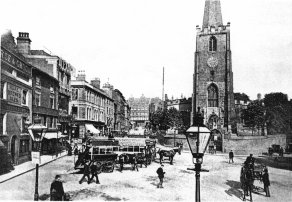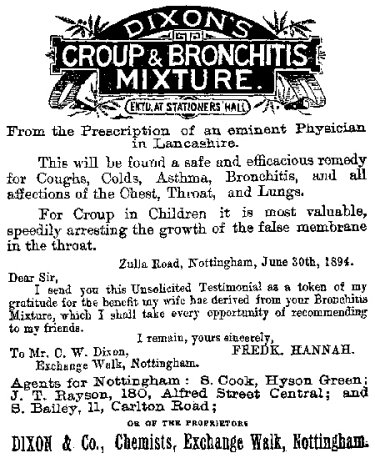
|
St Peter's Magazine, January 1901
 Early in 1994 Mr Barry Chappell, from Chilwell, brought to the church an old volume he had discovered among his late mother's possessions, a bound-up set of St Peter's Church Magazine for the years 1901 and 1902. Mr Chappell had no idea how his mother had come by the volume. He allowed us to photocopy the magazine and we now have new insights into life at St Peter's a hundred years ago.
Early in 1994 Mr Barry Chappell, from Chilwell, brought to the church an old volume he had discovered among his late mother's possessions, a bound-up set of St Peter's Church Magazine for the years 1901 and 1902. Mr Chappell had no idea how his mother had come by the volume. He allowed us to photocopy the magazine and we now have new insights into life at St Peter's a hundred years ago.
The parish
At that time St Peter's parish was very different, though the church itself has not changed so much. St James's parish still existed, so The Park was not part of St Peter's responsibilities, though the Rectory was already on Standard Hill. Most of the better-off members of the congregation lived outside the parish, which covered some of the poorest housing in Nottingham: the Broad Marsh slums. Articles published by Allan Derry in our Magazine in more recent years make it obvious how much overcrowding and deprivation there was there before the clearances of the 1960s. Much of St Peter's "secular" activities focused on providing social services to the poor of the parish at a time when there was no welfare state.
Despite its reputation for violence, the Broad Marsh was a colourful area. "Here congregated the men with barrel organs, the men who paraded the streets with Russian bears, and many other vagrants", wrote a former teacher in St Peter's Church School, who also remembered the kindness of the trades-people. They would supply whole barrels of apples for the school Christmas Party.
St Peter's Square was the terminus of several tram routes (electric trams were just taking over from the old horse trams). Some of the 1901 shops are still recognisable today - notably Sisson and Parker's bookshop (now Waterstone's) at the foot of Wheelergate - but Marks & Spencer's had not yet arrived!
The magazine
Turning to the magazine, it was made up of four pages of St Peter's information, plus the insert "The Church Monthly". At the foot of each page was a single line advert for Pyatt's the baby's outfitters, who also sold "corsets, umbrellas, ribbons and gloves".
The first page was blocked to present a calendar of events for the month, the remaining three pages being divided into two columns.
The church events advertised in January 1901 included seventeen services over the whole month, of which four were with or followed by Holy Communion, and two were listed as "Divine Service". The latter were for the two festivals in January apart from the Epiphany, the "Circumcision of our Lord" (Tuesday) and the "Conversion of St Paul" (Friday). Most of the Sunday services, apart from the 8am Communion, were Morning or Evening Prayer and the regular midweek Tuesday evening service was listed as "Evening Prayer with Sermon". In addition there were Sunday schools, morning and afternoon, and Bible classes, which were held in the vestry - one for Young Women on Sundays at 2.40pm and one held by the Rector on Fridays at 3.30pm Choir practice was held every Friday at 8pm. The Calendar also listed the readings for each of the principal Sunday services of the month.
Page two
Page two begins with a half page block listing important people in the church's hierarchy: Clergy (the Revd. George Edgcombe); Churchwardens; Sidesmen (there were no women); Organist; Sunday school superintendents and teachers for boys and girls; Day school headteachers and teachers for boys, girls and infants; and where to apply for a free pew! There is no curate listed due to a lengthy vacancy at that time.
This is followed by the motto for the month - a seasonal text from Isaiah 12 (14): "I will help thee, saith the Lord". Then comes a meditation on it by the Rector relevant to the start of the new year. He considers how "the Lord Jesus [will] speak to each of us" and cites the vision of an earlier preacher who portrayed Him speaking to each person saying "I will help thee!". This vision includes comparing people to ants faced with the abundance of the harvest of the "United Trinity": the Father's wisdom, the Son's love, and the power of the Spirit.
Page three
Page three is largely taken up with an eulogy on Councillor E. Denman of 16 St James' Street who died on 16th December 1900. He had played a full part in the life of St Peter's including that of a boys' Sunday school teacher. A description of his funeral "amidst many manifestations of regret and esteem" included a comment that the 39th Psalm was most impressively rendered by the choir.
Page four
The final page lays out how the church had raised money (at the annual sale of work and from Sunday offertories), what it spent it on, and who had donated some of it. The "Sick Poor" were notably regular recipients of the Sunday Offertories (seven of the sixteen in January 1901). However the size of giving indicates the poverty of the parish. At a time when the average worker's wage was about £1.20p a week, total giving for the Sick Poor in December 1900 averaged 18s.7d. [about £0.92p] each time. The rest of the Offertories (apart from a derisory one at a 3.00pm service of 12s.7d [£0.62] for the Children's Hospital) went to church expenses, averaging £1 8s.7d [£1.42p] a time.
The outreach work of the parish was also reflected in the secular activities listed in the Calendar, and again indicating the poverty in the residential parish. The Band of Hope (temperance movement) met on alternate Wednesdays at 7.30pm in one of the church's schools. The mothers' meeting and clothing club met every Monday in the schools at 2.15pm. The Girls' Friendly Society met every week on alternate Tuesdays and Wednesdays in Heathcote Street at 7.30pm to offer Bible study and social support to factory girls, especially those living away from home. The Girls' Evening Home met every Monday at 7.45pm. To encourage thrift and saving a Penny Bank opened, also every Monday at 7.45pm in the schools: it was managed by the Rector, the parish clerk Arthur Salsbury, and twelve other men (again, no women), including two of the Sidesmen.
The remaining part of page four was taken up with an advertisement for Dixon's Croup and Bronchitis mixture.
|
|
Myra Chilvers writes to report that the above advertisement is "more than an advertisement - a family link". Among the agents listed for Dixon's Mixture is Sambourne Cook, pharmacist, later Sheriff of Nottingham and Myra's great-uncle. His wife Maude was sister to Myra's grandmother Lucy Clarke, née Shaw. Myra's mother Kathleen Synyer, née Clarke, had an elder brother Herbert Renshaw Clarke, who was apprenticed to his uncle Sambourne Clarke and later took over his shop.
Links
Return to the History contents page
http://www.stpetersnottingham.org/1901/01.html
© St Peter's Church, Nottingham
Last revised 17th March 2001
